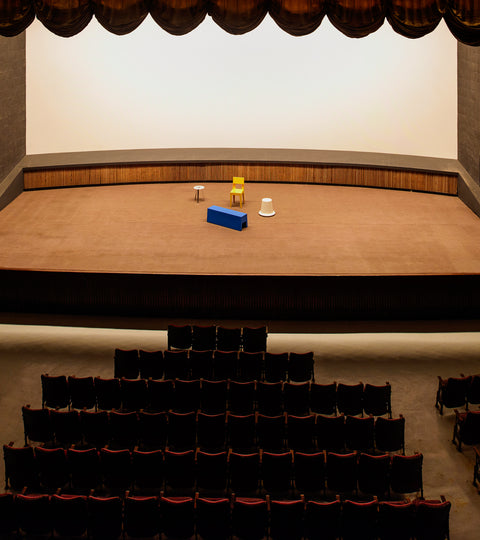
Although in recent years, the theatre has struggled to compete against multiplexes, in its prime, Regal was considered the city’s most glamorous film theatre, a place where the city’s elite would go to watch the latest Hollywood releases and a place that had the likes of Rabindranath Tagore, Prime Minister Jawaharlal Nehru and President Rajendra Prasad amongst its patrons.
The theatre is considered to mark the beginning of the age of art deco in Mumbai. It was also the first theatre in the country to be air conditioned, the first to screen films in Cinemascope, and interestingly, the first to have soda fountains! It also introduced Mumbai to neon lighting.
 Built in the cinema boom in the early 1930s, Regal Cinema was designed by architect, Charles Stevens, son of the famous architect F.W. Stevens (best known for designing Chhatrapati Shivaji Terminus and the Municipal Corporation Building in Mumbai). The theatre was constructed by Structural Engineering Works Limited (then Bhagat & Sons, Engineers), who boasted that, “The Regal Cinema was the first of its kind in India to have a gallery supported on a 70-foot clear span girder with supporting columns, thus enabling a clear unobstructed view to the patrons.”
Built in the cinema boom in the early 1930s, Regal Cinema was designed by architect, Charles Stevens, son of the famous architect F.W. Stevens (best known for designing Chhatrapati Shivaji Terminus and the Municipal Corporation Building in Mumbai). The theatre was constructed by Structural Engineering Works Limited (then Bhagat & Sons, Engineers), who boasted that, “The Regal Cinema was the first of its kind in India to have a gallery supported on a 70-foot clear span girder with supporting columns, thus enabling a clear unobstructed view to the patrons.”
The first movie to screen at Regal was the 1933 Laurel and Hardy film, The Devil’s Brother. For which they even received a telegram from the duo wishing them luck for the screening!

HERE'S AN EXCERPT FROM AN ARTICLE BY BHANUJ KHAPPAL IN MINT:
“Influenced by Cubism, Fauvism and art and architecture from the Global South, Art Deco was an early 20th century design movement that combined a fascination with modernity and technology with elements borrowed from traditional and pre-modern styles. By the 1930s, when the Back Bay reclamation project wrenched large tracts of land from the sea and kick—started a new construction boom, Mumbai’s professional and mercantile classes had fully embraced the Art Deco movement. In the shadow of the British Raj’s imperial Victorian architecture, hundreds of new buildings popped up, designed with the bold geometric forms and colourful vibrancy of this new international style. For this generation of Indian architects—and the Indian owners who financed their creations—the adoption of the art deco style was a means of self-assertion, a sign of Mumbai taking its place alongside other cosmopolitan metropolises like New York, Paris and Beirut.’’
 “I think Art Deco was Bombay’s national style,’’ says Mumbai-based historian and author Simin Patel, adding that Art Deco wasn’t just attractive to the city’s elite, but also to its newly assertive middle classes. “These architects chose art deco as their design motif because they were like ‘To hell with neo-Gothic and Indo-Saracenic, we want this global style as our signature national style’. It’s a kind of modernity that I think Bombay was ready for.’’
“I think Art Deco was Bombay’s national style,’’ says Mumbai-based historian and author Simin Patel, adding that Art Deco wasn’t just attractive to the city’s elite, but also to its newly assertive middle classes. “These architects chose art deco as their design motif because they were like ‘To hell with neo-Gothic and Indo-Saracenic, we want this global style as our signature national style’. It’s a kind of modernity that I think Bombay was ready for.’’
In a sense, Regal is a perfect example of this transition from British imperialism to local Mumbaikar cosmopolitanism.
 Our very first studio was located in a film studio called Famous Studio in Mahalaxmi, Mumbai. We were surrounded by those in the cinema business. We would walk into the building and be amazed by the transformation made possible by set design, the magic of it all.
Our very first studio was located in a film studio called Famous Studio in Mahalaxmi, Mumbai. We were surrounded by those in the cinema business. We would walk into the building and be amazed by the transformation made possible by set design, the magic of it all.
Today, we share the entrance to our studio with the exit of the cinema’s balcony. And on occasion, we can walk into the balcony and experience the glory of a single screen theatre. The overall sense of working is elevated by nostalgia of great films—each of which is riddled with memories from our time at the movies and has formed a part of who we are today.

